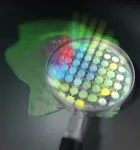(Press-News.org) Use of the delivery system in mouse models results in unprecedented siRNA penetration across the intact blood brain barrier
Technology could offer potential for a variety of human neurological disorders
In the past few decades, researchers have identified biological pathways leading to neurodegenerative diseases and developed promising molecular agents to target them. However, the translation of these findings into clinically approved treatments has progressed at a much slower rate, in part because of the challenges scientists face in delivering therapeutics across the blood-brain barrier (BBB) and into the brain. To facilitate successful delivery of therapeutic agents to the brain, a team of bioengineers, physicians, and collaborators at Brigham and Women's Hospital and Boston Children's Hospital created a nanoparticle platform, which can facilitate therapeutically effective delivery of encapsulated agents in mice with a physically breached or intact BBB. In a mouse model of traumatic brain injury (TBI), they observed that the delivery system showed three times more accumulation in brain than conventional methods of delivery and was therapeutically effective as well, which could open possibilities for the treatment of numerous neurological disorders. Findings were published in Science Advances.
Previously developed approaches for delivering therapeutics into the brain after TBI rely on the short window of time after a physical injury to the head, when the BBB is temporarily breached. However, after the BBB is repaired within a few weeks, physicians lack tools for effective drug delivery.
"It's very difficult to get both small and large molecule therapeutic agents delivered across the BBB," said corresponding author Nitin Joshi, PhD, an associate bioengineer at the Center for Nanomedicine in the Brigham's Department of Anesthesiology, Perioperative and Pain Medicine. "Our solution was to encapsulate therapeutic agents into biocompatible nanoparticles with precisely engineered surface properties that would enable their therapeutically effective transport into the brain, independent of the state of the BBB."
The technology could enable physicians to treat secondary injuries associated with TBI that can lead to Alzheimer's, Parkinson's, and other neurodegenerative diseases, which can develop during ensuing months and years once the BBB has healed.
"To be able to deliver agents across the BBB in the absence of inflammation has been somewhat of a holy grail in the field," said co-senior author Jeff Karp, PhD, of the Brigham's Department of Anesthesiology, Perioperative and Pain Medicine. "Our radically simple approach is applicable to many neurological disorders where delivery of therapeutic agents to the brain is desired."
Rebekah Mannix, MD, MPH, of the Division of Emergency Medicine at Boston Children's Hospital and a co-senior author on the study, further emphasized that the BBB inhibits delivery of therapeutic agents to the central nervous system (CNS) for a wide range of acute and chronic diseases. "The technology developed for this publication could allow for the delivery of large number of diverse drugs, including antibiotics, antineoplastic agents, and neuropeptides," she said. "This could be a game changer for many diseases that manifest in the CNS."
The therapeutic used in this study was a small interfering RNA (siRNA) molecule designed to inhibit the expression of the tau protein, which is believed to play a key role in neurodegeneration. Poly(lactic-co-glycolic acid), or PLGA, a biodegradable and biocompatible polymer used in several existing products approved by the U.S. Food and Drug Administration, was used as the base material for nanoparticles. The researchers systematically engineered and studied the surface properties of the nanoparticles to maximize their penetration across the intact, undamaged BBB in healthy mice. This led to the identification of a unique nanoparticle design that maximized the transport of the encapsulated siRNA across the intact BBB and significantly improved the uptake by brain cells.
A 50 percent reduction in the expression of tau was observed in TBI mice who received anti-tau siRNA through the novel delivery system, irrespective of the formulation being infused within or outside the temporary window of breached BBB. In contrast, tau was not affected in mice that received the siRNA through a conventional delivery system.
"In addition to demonstrating the utility of this novel platform for drug delivery into the brain, this report establishes for the first time that systematic modulation of surface chemistry and coating density can be leveraged to tune the penetration of nanoparticles across biological barriers with tight junction," said first author Wen Li, PhD, of the Department of Anesthesiology, Perioperative and Pain Medicine.
In addition to targeting tau, the researchers have studies underway to attack alternative targets using the novel delivery platform.
"For clinical translation, we want to look beyond tau to validate that our system is amenable to other targets," Karp said. "We used the TBI model to explore and develop this technology, but essentially anyone studying a neurological disorder might find this work of benefit. We certainly have our work cut out, but I think this provides significant momentum for us to advance toward multiple therapeutic targets and be in the position to move ahead to human testing."
INFORMATION:
This work was supported by the National Institutes of Health (HL095722), Fundac?a?o para a Cie?ncia e a Tecnologia through MIT-Portugal (TB/ECE/0013/2013), and the Football Players Health Study at Harvard, funded by a grant from the National Football League Players Association.
Karp has been a paid consultant and or equity holder for multiple biotechnology companies (listed here). Joshi, Karp, Mannix, Li, Qiu and Langer have one unpublished patent based on the nanoparticle work presented in this manuscript.
Paper cited: Li, W et al. "BBB pathophysiology independent delivery of siRNA in traumatic brain injury" Science Advances DOI: 10.1126/sciadv.abd6889
Fluorescence microscopy is widely used in biochemistry and life sciences because it allows scientists to directly observe cells and certain compounds in and around them. Fluorescent molecules absorb light within a specific wavelength range and then re-emit it at the longer wavelength range. However, the major limitation of conventional fluorescence microscopy techniques is that the results are very difficult to evaluate quantitatively; fluorescence intensity is significantly affected by both experimental conditions and the concentration of the fluorescent substance. Now, a new study by scientists from Japan is set to revolutionize the field of fluorescence lifetime ...
LOS ANGELES (Dec. 30, 2020) -- People who move due to unaffordable housing are at increased risk of failing to receive the medical care they need, according to a new study from Cedars-Sinai and the University of California, Los Angeles. The study, published online in the Journal of General Internal Medicine, concludes that the result could be long-term health problems.
The findings were based on 146,417 adults who responded from 2011 to 2017 to the California Health Interview Survey, the largest such state survey in the U.S. ...
One of the physiopathological characteristics of COVID-19 that has most baffled the scientific and medical community is what is known as "silent hypoxemia" or "happy hypoxia". Patients suffering this phenomenon, the causes of which are still unknown, have severe pneumonia with markedly decreased arterial blood oxygen levels (known as hypoxemia). However, they do not report dyspnea (subjective feeling of shortness of breath) or increased breathing rates, which are usually characteristic symptoms of people with hypoxemia from pneumonia or any other cause.
Patients with "silent hypoxemia" often suffer ...
BOSTON -- Pregnant women may be especially vulnerable to developing more severe cases of COVID-19 following SARS-CoV-2 infection, but little is known about their anti-SARS-CoV-2 immune response or how it may affect their offspring. In a study published in JAMA Network Open, a group led by investigators at Massachusetts General Hospital (MGH) provides new insights that could help improve care for these women and their newborns and emphasizes the need for pregnant women to be considered in vaccine rollout plans.
The study included 127 pregnant women in their third trimester who received care at three Boston hospitals between April 2 and June 13, ...
Pregnant women who are infected with SARS-CoV-2, the virus that causes COVID-19, during the third trimester are unlikely to pass the infection to their newborns, suggests a study funded by the National Institutes of Health. The study followed 127 pregnant women who were admitted to Boston hospitals during the spring of 2020. Among the 64 pregnant women who tested positive for SARS-CoV-2, no newborns tested positive for the virus. NIH support was provided by the Eunice Kennedy Shriver National Institute of Child Health and Human Development (NICHD), the National Heart, Lung, and Blood Institute (NHLBI), and the National Institute of Allergy and Infectious ...
Surgery, in addition to treatments like chemotherapy and radiation therapy, may increase the length of survival for metastatic breast cancer patients, according to Penn State College of Medicine and Penn State Cancer Institute researchers. They studied nearly 13,000 stage four breast cancer patients and found that those who had surgery in addition to their other treatments had a survival advantage over those who had other treatments alone.
Stage four breast cancer accounts for 6% of newly diagnosed breast cancer cases. Systemic therapy, which may include treatments like chemotherapy, hormone therapies and immunotherapies, ...
Toronto, CANADA - Attention Deficit Hyperactive Disorder (ADHD) can have negative consequences on mental health into adulthood. A nationally representative Canadian study reported that the lifetime prevalence of suicide attempts was much higher for women who had ADHD (24%) compared to women who had not (3%). Men with ADHD were also more likely to have attempted suicide compared to men without ADHD (9% vs. 2%).
"ADHD casts a very long shadow. Even when we took into account history of mental illness, and the higher levels of poverty and early adversities that adults with ADHD often experience, those with ...
Juries in criminal cases typically decide if someone is guilty, then a judge determines a suitable level of punishment. New research confirms that these two separate assessments of guilt and punishment - though related -- are calculated in different parts of the brain. In fact, researchers found that they can disrupt and change one decision without affecting the other.
New work by researchers at Vanderbilt University and Harvard University confirms that a specific area of the brain, the dorsolateral prefrontal cortex, is crucial to punishment decisions. Researchers predicted ...
Humans are unique among social creatures in their willingness to bear personal costs to punish those who have harmed others. A study published September 16 in Neuron reveals new insights into our unparalleled sense of justice, specifically, the precise role of the dorsolateral prefrontal cortex (DLPFC)--one of the most recently evolved regions in the human brain. The findings reveal that DLPFC integrates information about a suspect's blameworthiness for wrongful acts and the resulting harm to others, enabling us to decide on the appropriate level of punishment.
"Despite ...
It's a question most attorneys wish they could answer: How and why do judges and juries arrive at their decisions?
The answer, Joshua Buckholtz said, may lie in the way our brains are wired.
A new study co-authored by Buckholtz, an Assistant Professor of Psychology, René Marois, professor and chair of psychology at Vanderbilt and colleagues, explains how a brain region called the dorsolateral prefrontal cortex (or DLPFC) coordinates third party punishment decisions of the type made by judges and juries. The study is described in a September 16 paper in Neuron. ...

